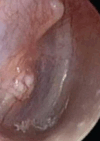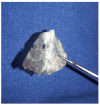A Comparative Study of Button Hole Technique Versus Underlay Technique in Type 1 Tympanoplasty
- PMID: 38440635
- PMCID: PMC10909008
- DOI: 10.1007/s12070-023-04338-4
A Comparative Study of Button Hole Technique Versus Underlay Technique in Type 1 Tympanoplasty
Abstract
Background: Tympanoplasty is the most common operation performed by an Otolaryngologist worldwide.Type 1 tympanoplasty involves repair of pars tensa of tympanic membrane, when the middle ear is normal. The most widely used method is underlay technique using temporalis facia. In buttonhole tympanoplasty, the temporalis fascia is anchored to the handle of malleus through the buttonhole.
Objective: To compare and analyze graft uptake and hearing outcome in button hole technique and underlay technique.
Material and method: It is a comparative study done at tertiary care center, where patients suffering from tubotympanic type of chronic otitis media with medium sized perforation with moderate conductive hearing loss, within age group of 18-60 years,were selected.
Results: In Button hole tympanoplasty group the mean hearing gain was 9.3dB, and 8.17 dB in Underlay tympanoplasty group which was statistically significant (p < 0.05) but P value between Button hole and Underlay tympanoplasty was not statistically significant.With regard to graft uptake 96.7% showed graft uptake in Buttonhole tympanoplasty group and in underlay tympanoplasty the graft uptake was 93.3%.
Interpretation and conclusion: Buttonhole technique is better in terms of graft uptake since the graft is anchored to the handle of malleus, and postoperatively medialisation of graft and other complications like lateralization of graft, epithelial pearl formation and anterior blunting is prevented. Both techniques are good in terms of hearing improvement for chronic otitis media with medium sized perforation with moderateconductive hearing loss.
Keywords: Button hole Technique; Chronic Otitis Media; Tympanoplasty; Underlay Technique.
© Association of Otolaryngologists of India 2023. Springer Nature or its licensor (e.g. a society or other partner) holds exclusive rights to this article under a publishing agreement with the author(s) or other rightsholder(s); author self-archiving of the accepted manuscript version of this article is solely governed by the terms of such publishing agreement and applicable law.
Conflict of interest statement
Conflict of interestNone declared.
Figures












References
-
- Quinton Pathology and clinical course of the inflammatory diseases of the middle ear, Aina JG, Lloyd B, Dennis SP (2010) Glasscock-Shambaugh Surgery of the ear, 6th edn. USA: People’s Medical Publishing House, pp 427–428
-
- Browning GG. Chronic otitis media. Browning GG. In: Merchant SN, Kelly G, Swan IR, Canter R, McKerrow WS, editors. Scott-brown’s otorhinolaryngology, head and neck Surgery. 7. Great Britain: edward arnold publishers ltd; 2008. pp. 3396–3439.
-
- Aristides AS (2010) Tympanoplasty: tympanic membrane repair. In: Aina JG, Lloyd B, Dennis SP (eds) Glasscock-Shambaugh Surgery of the ear, 6th edn. USA: People’s Medical Publishing House, pp 465–488
-
- Shankar G. A Narendranath A Buttonhole Tympanoplasty j Otolaryn. 2014;3(5):81–83.
-
- .Wallstein H (1952) Fusktionelle Operationen in Mittelohr Mit Hilfe Des Freien Spalt lappen transplantes. Arch Ohren Naseen-u-Kehlkoph, pp 161–242
LinkOut - more resources
Full Text Sources
Miscellaneous
